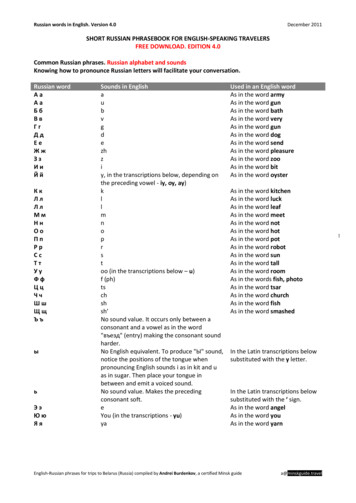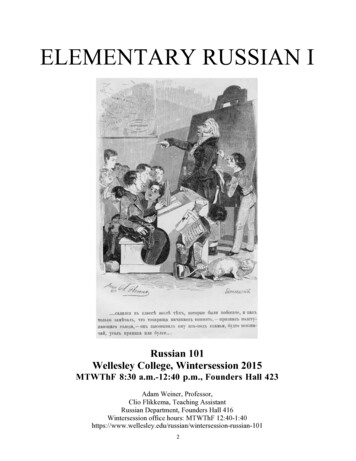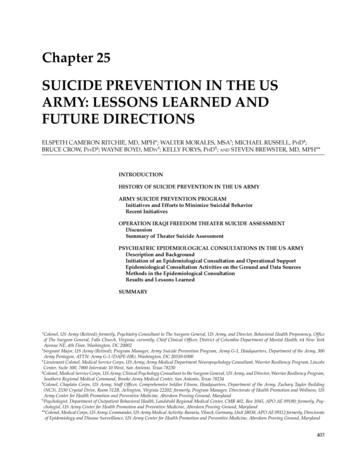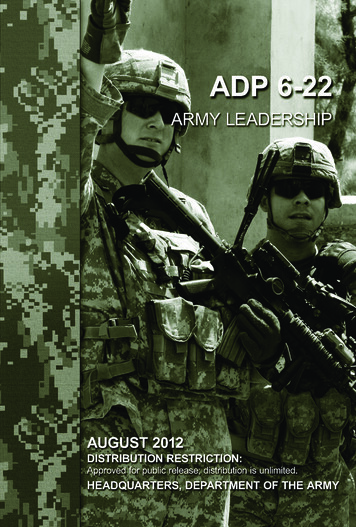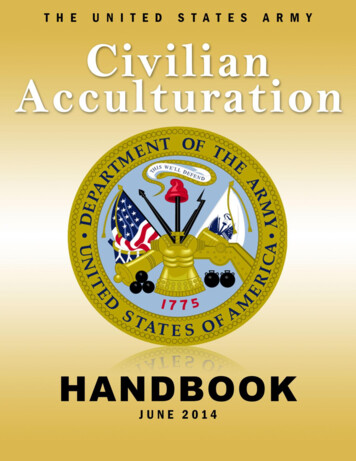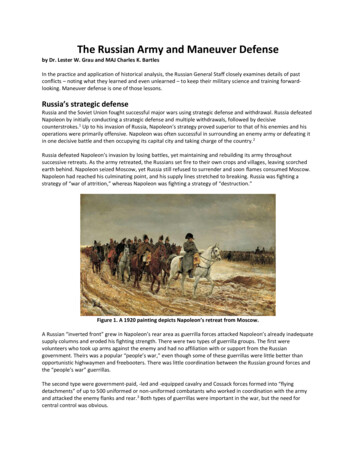
Transcription
The Russian Army and Maneuver Defenseby Dr. Lester W. Grau and MAJ Charles K. BartlesIn the practice and application of historical analysis, the Russian General Staff closely examines details of pastconflicts – noting what they learned and even unlearned – to keep their military science and training forwardlooking. Maneuver defense is one of those lessons.Russia’s strategic defenseRussia and the Soviet Union fought successful major wars using strategic defense and withdrawal. Russia defeatedNapoleon by initially conducting a strategic defense and multiple withdrawals, followed by decisivecounterstrokes.1 Up to his invasion of Russia, Napoleon’s strategy proved superior to that of his enemies and hisoperations were primarily offensive. Napoleon was often successful in surrounding an enemy army or defeating itin one decisive battle and then occupying its capital city and taking charge of the country.2Russia defeated Napoleon’s invasion by losing battles, yet maintaining and rebuilding its army throughoutsuccessive retreats. As the army retreated, the Russians set fire to their own crops and villages, leaving scorchedearth behind. Napoleon seized Moscow, yet Russia still refused to surrender and soon flames consumed Moscow.Napoleon had reached his culminating point, and his supply lines stretched to breaking. Russia was fighting astrategy of “war of attrition,” whereas Napoleon was fighting a strategy of “destruction.”Figure 1. A 1920 painting depicts Napoleon’s retreat from Moscow.A Russian “inverted front” grew in Napoleon’s rear area as guerrilla forces attacked Napoleon’s already inadequatesupply columns and eroded his fighting strength. There were two types of guerrilla groups. The first werevolunteers who took up arms against the enemy and had no affiliation with or support from the Russiangovernment. Theirs was a popular “people’s war,” even though some of these guerrillas were little better thanopportunistic highwaymen and freebooters. There was little coordination between the Russian ground forces andthe “people’s war” guerrillas.The second type were government-paid, -led and -equipped cavalry and Cossack forces formed into “flyingdetachments” of up to 500 uniformed or non-uniformed combatants who worked in coordination with the armyand attacked the enemy flanks and rear.3 Both types of guerrillas were important in the war, but the need forcentral control was obvious.
Figure 2. As irregular cavalry, the Cossack horsemen of the Russian steppes were best suited to reconnaissance,scouting and harassing the enemy’s flanks and supply lines.The Russian army refused to provide Napoleon with the opportunity for a decisive battle that would fit his strategyof destruction. Napoleon began his withdrawal from the ashes of Moscow Oct. 16, hoping to beat the Russianwinter. He did not. Napoleon abandoned his army as it disintegrated and froze. Some 27,000 soldiers of theoriginal 500,000-strong Grand Armée survived.In October 1813, the coalition of Russia, Prussia, Austria and Sweden defeated Napoleon’s reconstituted army atLeipzig. Just before the Battle of Leipzig, Wellington’s army defeated the French army in Spain and Portugal andthen crossed into France. The Russian army constituted part of the occupation force in Paris.Their attrition strategy of fighting battles and retreating while reconstituting their force and sapping the enemystrength, coupled with a strong series of counterstrokes, worked. Russia had traded space for time, drawingNapoleon deep into Russia, overextending his supply lines over Russia’s muddy, often-impassable roads andlaunching counterstrokes at the opportune time.The Soviet Union did not intend to defeat Nazi Germany in this fashion, but after bungling the initial period of war,they inadvertently emulated Tsar Alexander I by fighting a retreat all the way to Moscow while building the forcesfor a series of counterstrokes. This time, Moscow held while the German effort culminated and their supply linesstretched to breaking. The muddy roads and “inverted front” of Moscow-controlled guerrillas complicated analready difficult German supply effort.After Kursk and Stalingrad, the Axis alliance was on the defensive and the operational counterstrokes of the RedArmy drove the invaders out of the Soviet Union and Eastern Europe. The Red Army constituted both the initial,and later part of the Allied occupation force in Berlin, deep within the Soviet Occupation Zone.4Russian maneuver defenseManeuver defense [манёвренная оборона] is a tactical and operational form of defense whose goal is to inflictenemy casualties, gain time and preserve friendly forces with the potential loss of territory. It is conducted, as arule, when there are insufficient forces and means available to conduct a positional defense. 5This differs from the U.S. concept of the mobile defense, which “is a type of defensive operation that concentrateson the destruction or defeat of the enemy through a decisive attack by a striking force. It focuses on destroying theattacking force by permitting the enemy to advance into a position that exposes him to counterattack and
envelopment. The commander holds most of his available combat power in a striking force for his decisiveoperation, a major counterattack. He commits the minimum possible combat power to his fixing force thatconducts shaping operations to control the depth and breadth of the enemy’s advance. The fixing force alsoretains the terrain required to conduct the striking force’s decisive counterattack.” 6This differs from the Russian concept in that the Russians do not intend to permit the enemy to advance tocounterattack. They intend to contest the enemy and reduce his forces without becoming decisively engaged.Russian maneuver battalions and brigades conduct maneuver defense, whereas the United States considersmobile defense as a corps-level fight.7 In future conventional maneuver war, continuous trench lines, engineerobstacles and fixed defenses extending across continents, as occurred in Europe in World Wars I and II, will notoccur. According to Russian military guidance, the maneuver defense, eventually leading to a positional defense,will be their primary defense and will be conducted by the maneuver brigades as their base formation. 8Maneuver defense occurred in medieval Russia but was realized as a new form of combat action near the closingof World War I.9 The first extensive use of maneuver defense occurred during the Russian civil war10 and was dueto a variety of equipment, political and geographic factors. The uneven distribution of weapons from World War I,the uncompromising goals of the Reds and the Whites, and the expanse of the territory on which the war wasfought were far better adapted to this dynamic, mobile form of combat, unlike the continuous trench-line warfareof Western Europe during World War I.During the Russian civil war, several echelons using unprepared lines and engineer obstacles initially conductedmaneuver defense. In a short time, however, it sometimes evolved to include positional defenses, coupled withactive counterattacking forces that conducted flanking attacks and encirclements. Daring cavalry raids into the rearof the enemy often distracted the enemy during necessary withdrawals to new lines or positions.11During the mid-war period, Western theorists such as J.F.C. Fuller discussed future war in terms of combined armsand new weapons such as the tank, airplane and radio. The Russians had actual practical experience in this newtheoretical maneuver war that their Western counterparts lacked. Granted, large horse-cavalry formations playeda much larger role than the few existing tanks present in the Russian civil war, but the scale and scope of thefighting in Russia incorporated the vision of that future combat. Victory would belong to the state that couldconcentrate superior forces to overwhelm an enemy at a particular location and could rapidly maneuver againstflanks, penetrate positions and encircle forces to destroy a thinly spread enemy.12The Red Army’s 1929 field regulations used the term подвижная оборона [mobile defense] in Article 230: “Mobiledefense takes place when the combatants do not defend to the end, rather slip away from the enemy and move toa reinforce a new defensive line when the operational concept is that it must sacrifice a portion of territory togain necessary time and protect the lives of the force.” 13The follow-on 1936 and 1939 field regulations provided recommendations for the preparation and conduct ofmobile defense. The 1936 field regulation envisioned two possible mobile defense maneuvers. With the first, twodefensive lines would leapfrog through each other; in the second, a strong rear guard would cover a singleretreating line. The 1939 field regulation slightly modified the 1936 guidance by discussing what conditions mayprecede initiating a mobile defense and what steps could be taken to strengthen the defense.The 1941 field regulation changed the term to маневренная оборона [maneuver defense]: “The maneuverdefense includes the conduct of a series of defensive battles leading to successive designated lines, synchronizedwith short surprise counterattacks. The maneuver defense forces are included in the coordinated maneuver of theforce using fires and the broad employment of all types of obstacles.”14The Germans invaded the Soviet Union June 22, 1941. The Soviet tried to organize counterstrokes while they wereretreating or were being enveloped. They failed. Initial positional defenses crumbled, nor could the Sovietsorganize a maneuver defense before it was overrun. The Wehrmacht reached the Mozhaisk defenses outside
Moscow by Oct. 13, 1941. The Mozhaisk defenses were a hastily constructed series of four lines of undermanneddefensive positions.General of the Armies Georgy Zhukov issued a special directive: “In the event that it is impossible to check theenemy offensive, transition to a maneuver defense.”15 A list of necessary planning steps and considerationsfollowed this directive. The Germans attacked through the end of October and ground to a halt. The Sovietsconducted maneuver defense in some sectors, upgraded and reinforced their other defenses, and stopped thesecond German offensive conducted Nov. 15 to Dec. 5; the Red Army slowly began their own counteroffensiveDec. 5. The operational-level maneuver defense had evolved. Divisions and regiments mainly conducted tacticallevel maneuver defense.‘To the death’Despite the Red Army’s success using maneuver defense, it disappeared from the 1948 field regulations. Theongoing concept of the unified defense [единой оборона] precluded such a variant to positional defense. AfterStalin’s death in 1953, the debate over the conduct of land warfare on the atomic battlefield began. Soviet groundforce structure dramatically changed as battalions became smaller, completely motorized or mechanized, lost theirorganic direct-fire artillery and received T-55 tanks with lead liners to soak up the radiation. Unfortunately for themotorized rifle soldiers, their personnel carriers and trucks had no such lining, although initial planning involveddriving over nuclear-irradiated zones in the attack.16 Defense would be temporary and positional.A lively debate began within the ground forces, positing that maneuver defense was optimum for the nuclearbattlefield. Marshal of the Soviet Union R. Ia. Malinovskiy, commander of Soviet Ground Forces, ended the debateon maneuver defense, stating: “This point of view is wrong and is completely unsuitable for these times. We donot have the right to train our forces, commanders and staffs where every commander, based on his ownjudgment, can abandon his [defensive] positions, regions and belts to maneuver. There is one unshakeable truthwith which we must conduct our lives – with unswerving stubbornness we will hold our designated lines andpositions, hold them to the death.”17At the end of the 1980s, the USSR Minister of Defense, Marshal of the Soviet Union Dmitry Yazov, re-establishedmaneuver defense in Soviet military theory as one of the accepted forms of defense. Technology and warfightingtechniques were changing. Deep fires, distance mining, ambushes, fire sacs, air assaults, flanking and raiddetachments were changing modern war and facilitating counterattacks. Maneuver defense fit within the changingdynamics.18Maneuver defense in contemporary combatSince the 1990-1991 Gulf War, ground forces have realized that unprotected maneuver in the open may lead todecimation. Less-modern ground forces have attempted to negate this by moving the fight to terrain that defeatsor degrades high-precision systems – mountains, jungle, extensive forest, swamps and cities – while conducting along-term war of attrition to sap the enemy’s political will.Difficult terrain will also be a valuable ally in future conventional maneuver war, as will camouflage, electronic andaerial masking, effective air-defense systems and secure messaging. Maneuver defense will clearly be a feature offuture conventional maneuver war.One thing that may change dramatically is the fundamental concept of the main, linear, positional defense towhich maneuver defense leads. Perhaps the main linear defense will be anchored in difficult terrain. Perhaps themain defense will more closely resemble the security-zone maneuver defense. The main defense may become anexpanded security zone containing counterstrike/counterattack forces and a concentration of high-precisionweapons systems. Open flanks may be covered by maneuvering artillery fires, aviation and positional forces notunder duress.The Russian concept of maneuver by fire may dominate the battlefield, as it alone may enable maneuver.19
The linear battlefield may be replaced by the fragmented, or nonlinear [очаговый], battlefield, where brigadesmaneuver like naval flotillas, deploying maneuver and fire subunits over large areas, protected by air-defensesystems, electronic warfare and particulate smoke. Strongpoints will be established and abandoned, artillery fireswill maneuver and difficult terrain will become the future fortresses and redoubts.Fragmented battlefieldWorld War I in the West was a positional fight where artillery, field fortifications and interlocking machinegun fireprevented maneuver. World War I in the East, however, was not always positional but was sometimes fluid. Theantithesis to the stalemate in the West was the tank. Yet the tank did not spell the end of linear defense. DuringWorld War II, the tank enabled maneuver in some places, but in other places, difficult terrain and integrateddefenses prevented maneuver and fires prevailed.For example, the Korean War began with a great deal of maneuver but stalemated into positional mountaincombat enabled by fires. Vietnam was about the maneuver of the helicopter, but difficult terrain dominated thebattlefield.The antitank guided missile and precision-guided munitions currently threaten maneuver. Still, advances in fires,electronic countermeasures, robotics and air defense may enable maneuver.As another example of an army using difficult terrain, the Serbian army proved quite adept at hiding and survivingin it during the 78-day Kosovo air war. What they lacked was an opposing ground force to combat at thetermination of the bombing.20The fragmented battlefield has become common following the Gulf War. The Soviet-Afghan war, the Angolan civilwar, the Chad-Libya conflicts, the Battle of Mogadishu, Operation Enduring Freedom, most of Operation IraqiFreedom, the Libyan civil war, the Sudan conflicts, the Saudi Arabian-Yemen conflict – all have involvedfragmented battlefields.21How do peer forces fight conventional maneuver war on a fragmented battlefield? Permanent combined-armsbattalions appear to be an important component.For decades, the Soviets and Russians have struggled with fielding, training supporting and fighting a combinedarms battalion with its own tanks, motorized rifle, artillery, antitank and support subunits capable of fighting andsustaining independently over a large area. Russian maneuver brigades now constitute one or two battaliontactical groups and are working to eventually achieve four.22The Russians have a long history of conducting a fragmented defense on a fragmented battlefield. The Russian civilwar is replete with such examples.23 During World War II, in addition to its large conventional force, the Sovietsfielded the largest partisan army in history. It conducted a fragmented offense and defense against a linearGerman force.23Afghanistan, Chechnya and now Syria also featured fragmented offense and defense.Analysis of Russian defenseIf the Russians fight a near-peer competitor, the maneuver defense may become the “normal” defense, with thepositional defense as an anomaly. In a maneuver defense, within the brigade the battalion is normally assigned anarea of responsibility of 10x10 kilometers (frontage and depth respectively), and a company position is up to twokilometers in frontage and up to one kilometer in depth. There is a distance of up to 1½ kilometers in depthbetween positions, which ensures mutual support of defending subunits and allows maneuver to the subsequentposition.25
Figure 3. Russian motorized rifle brigade in a maneuver defense. (Diagram by Charles K. Bartles)26Figure 3 shows a Russian motorized rifle brigade in a maneuver defense.27 Battalion positions are shown, andcompany fighting positions are depicted within the battalion positions, showing that the companies will fight frommore than one position within each battalion position. The brigade defends against an attack from the west withits tank battalion to the north and 3rd Motorized Rifle Battalion to the south. The 2nd Motorized Rifle Battalion isdeployed further to the west in forward positions and is not initially shown on this diagram.The tank and 3rd Motorized Rifle Battalion cover three enemy high-speed avenues of approach. The northernapproaches are considered the most dangerous. The enemy initially engages 2 nd Motorized Rifle Battalion, whichforces the enemy to deploy and slows his advance while Russian artillery or aviation fire damages the enemyadvance. The 2nd Motorized Rifle Battalion does not become decisively engaged. Rather, it withdraws to the northand through the tank battalion, moves past 1st Motorized Rifle Battalion and occupies a defensive position in thenorth.28The enemy then engages the tank battalion and 3rd Motorized Rifle Battalion, which again forces the enemy todeploy while Russian aviation or artillery fire again damages the enemy advance. Neither battalion becomesdecisively engaged but withdraws. The tank battalion withdraws under the covering fire of 1 st Motorized RifleBattalion, moves through 2nd Motorized Rifle Battalion and assumes a central defensive position to the east. The3rd Motorized Rifle Battalion moves directly back and goes on-line with 2nd Motorized Rifle Battalion to its north.The enemy continues to advance and is engaged by 1st Motorized Rifle Battalion and the tank battalion, whichagain forces the enemy to deploy while being engaged by Russian artillery or aviation. The 1 st Motorized RifleBattalion and tank battalion do not become decisively engaged but move to a new position north of the tankbattalion.The enemy continues to advance and is engaged by Russian artillery or aviation fires while deploying against 2 ndand 3rd Motorized Rifle Battalions. The 2nd and 3rd Motorized Rifle Battalions do not become decisively engaged.The 2nd Motorized Rifle Battalion again moves directly back and goes on-line with the tank battalion to its north.
The 2nd Motorized Rifle Battalion moves through 1st Motorized Rifle Battalion and tank battalion to take up areserve position or to deploy as a forward detachment to start the sequence again.Figure 4. Motorized rifle brigade in a maneuver defense. (Diagram by Charles K. Bartles)29Figure 4 shows a Russian motorized rifle battalion in a maneuver defense within its initial battalion box. (In thiscase, it is the initial position of 3rd Motorized Rifle Battalion in the brigade-defense figure.) The battalion is facingan enemy attack from the west and has a reconnaissance patrol forward. The battalion has a shallow security zoneconsisting of a motorized rifle squad in ambush to the north, a motorized rifle platoon reinforced with a tank,obstacles and two mixed minefields in the center, and a tank in ambush protected by a mixed minefield.The battalion mortar battery is in the security zone in support of these elements. As the security-zone elementswithdraw and reposition, the enemy is met by three motorized rifle companies (of two platoons each) on-line. Thecompanies are reinforced by a tank platoon and protected by seven mixed minefields. Man-portable air-defensesystems are moved up to the rear of the company positions. The mortar battery has repositioned behind thecenter company. There are four firing lines for the antitank reserve protecting the flanks and junctures of thecompanies. The third platoons of the forward companies occupy fighting positions in an intermediate line fromwhich they can cover the withdrawal of their companies. Three self-propelled artillery batteries are located each insupport of a forward company but able to mass fires. The battalion command post is centrally located.The companies do not become decisively engaged but withdraw under the covering fire of their rear platoon totake up new positions. The north and south companies move directly back to new positions in an alternate line,while the combined-arms reserve and anti-landing reserve cover the center. The central company moves furtherback on-line with the forward-company reserves and the on-order positions of the combined-arms reserve andanti-landing reserve in an intermediate line. The battalion command post, mortar battery and three artillerybatteries move behind the final position shown on Figure 4.
The enemy advance encounters a line of six platoons that cause the enemy to deploy and slow down while beinghit with artillery or aviation strikes. This line does not become decisively engaged but withdraws behind the twocompanies now on an alternate line with on-order positions for the combined-arms reserve and anti-landingreserve. Again, the enemy attack is slowed and punished, and then the line withdraws to its eastern position withthe battalion on this alternate line. After slowing and punishing the advancing enemy, the battalion withdraws toits next battalion box, handing the battle off to a supporting battalion.The battalion defends a 10-kilometer-by-10-kilometer box. Russians consider that normally there will be a two- to2½-kilometer distance between intermediate and alternate lines. The rate of advance of the enemy fightingthrough the defensive positions is problematic; however, the Russians calculate that, should the Russian defensivepositions prove stable, standard values in average conditions find that the enemy may be capable of covering thedistance between defensive lines in one to 1½ hours. Depending on the location of supporting helipads, aviationsupport must function quickly and effectively to mitigate this advance, particularly should the enemy attempt toflank or encircle the defenders using ground and air-assault forces.30Thus, in a maneuver defense, defending troops displace from line to line both deliberately and when forced. Theenemy organizes pursuit with the interdiction of routes of withdrawal and attacks from the flanks and rear. Theseactions require separate fire support in which army aviation units are assigned to support covering-force subunitsand rear guards, to engage flanking detachments and to slow the rate of pursuit. In certain sectors, maneuver willbe combined with blocking and employment of flanking and raiding detachments. 31ConclusionIn conventional maneuver war under nuclear-threatened conditions, maneuver defense leading to a positionaldefense seems most likely to Russian theorists and planners. The preceding example is conducted on fairly openterrain, and the distances and dispositions will change with the terrain.Skilled maneuver defense is designed to destroy enemy systems at long range and then withdrawing withoutbecoming decisively engaged. Aviation and artillery are key to this long-range destruction but do not work thesame target simultaneously. Artillery usually fights the enemy in front of the ground formation, while aviationfights any enemy trying to flank or encircle the defenders.A key target for both aviation and artillery is mobile enemy air defense. The Soviets and now the Russians havelong worked on developing a system that could detect, target and destroy high-priority targets in near-real-time.The Russian reconnaissance-fire complex now links reconnaissance assets with a command and fire-directioncenter with dedicated artillery, missiles and aviation for destruction of priority enemy targets in near-real-time.This system is tied in with the aviation and maneuver headquarters and will be involved in the maneuver defensewhen appropriate.Maneuver defense requires close coordination between fires and maneuver. Maneuver-force tactical training tosupport it will probably include mutual covering, withdrawal and counterattack drills. Engineers should train inrapid obstacle placement and movement support to support this defense. Artillery battalions should more oftenfire in support of individual maneuver battalions than as a group. Artillery batteries should often be attached tomaneuver companies.Widespread camouflage discipline and use of corner reflectors are probable. Push-supply-forward should beexpected, and evacuation collection point establishment should be part of maintenance and medical training.Battle-damaged systems need to be immediately repaired or evacuated in situations where terrain is being tradedfor time and advantage.Maneuver defense is appropriate to combat conducted in Russia or on its southern and western boundaries. It isagain part of Russian military theory and practice.
Dr. Les Grau, a retired U.S. Army infantry lieutenant colonel, is the Foreign Military Studies Office (FMSO)’s researchdirector. Previous positions include senior analyst and research coordinator, FMSO, Fort Leavenworth, KS; deputydirector, Center for Army Tactics, U.S. Army Command and General Staff College, Fort Leavenworth; political andeconomic adviser, Allied Forces Central Europe, Brunssum, The Netherlands; U.S. Embassy, Moscow, Soviet Union;battalion executive officer, 2‐9th Infantry, Republic of Korea and Fort Riley, KS; commander, Headquarters andHeadquarters Company, 1st Support Brigade, Mannheim, Germany; and district senior adviser, Advisory Team 80,Republic of Vietnam. His military schooling includes U.S. Air Force War College, U.S. Army Russian Institute, DefenseLanguage Institute (Russian), U.S. Army Command and General Staff College, Infantry Officer Advanced Course andInfantry Officer Basic Course. He has a bachelor’s of arts degree in political science from the University of Texas‐ElPaso; a master’s of arts degree in international relations from Kent State University; and a doctorate in Russian andCentral Asian military history from the University of Kansas. His awards and honors include U.S. Central CommandVisiting Fellow; professor, Academy for the Problems of Security, Defense and Law Enforcement, Moscow;academician, International Informatization Academy, Moscow; Legion of Merit; Bronze Star; Purple Heart; andCombat Infantry Badge. He is the author of 13 books on Afghanistan and the Soviet Union and more than 250articles for professional journals. Dr. Grau’s best‐known books are The Bear Went Over the Mountain: SovietCombat Tactics in Afghanistan and The Other Side of the Mountain: Mujahideen Tactics in the Soviet‐AfghanWar.MAJ Chuck Bartles is an analyst and Russian linguist with FMSO, Fort Leavenworth. His specific research areasinclude Russian and Central Asian military force structure, modernization, tactics, officer and enlisted professionaldevelopment, and security-assistance programs. MAJ Bartles is also a space-operations officer and major in theArmy Reserve who has deployed to Afghanistan and Iraq, and who has served as a security‐assistance officer atembassies in Kyrgyzstan, Uzbekistan and Kazakhstan. MAJ Bartles has a bachelor’s of arts degree in Russian fromthe University of Nebraska‐Lincoln, a master’s of arts degree in Russian and Eastern European Studies from theUniversity of Kansas, and is a PhD candidate at the University of Missouri-Kansas City.FMSO assesses regional military and security issues through open-source media and direct engagement withforeign military and security specialists to advise U.S. Army leadership on issues of policy and planning critical tothe Army and the wider military community. Forward comments about this article to FMSO, ATIN-F Dr. Grau, 731McClellan Avenue, Fort Leavenworth, KS 66027-1350. Or email Dr. Grau at lester.w.grau.civ@mail.mil.Notes1P.A. Zhilin, Отечественная Война 1812 года [The Fatherland War of 1812], Moscow: Nauka, 1988.Ibid. Austria 1805 and Prussia 1806.3 Lester W. Grau and Michael Gress, The Red Army Do-It-Yourself Nazi-Bashing Guerrilla Warfare Manual (The Partisan’sCompanion), Havertown, PA: Casemate, 2010. Translation and commentary of the 1943 Soviet edition, Спутник Партизана,used to train partisans to fight the Nazis.4 David M. Glantz and Jonathan House, When Titans Clashed: How the Red Army Stopped Hitler, Lawrence, KS: University Pressof Kansas, 1995. This book remains the premier short history of the Soviet Union’s defense and series of operationalcounterstrokes that defeated Germany in World War II.5 Ministry of Defense of the Russian Federation, Манёвренная оборона, Военный энциклопедический словар в двухтомак [Military Encyclopedic Dictionary in Two Volumes], Volume II, Moscow:
Russia and the Soviet Union fought successful major wars using strategic defense and withdrawal. Russia defeated Napoleon by initially conducting a strategic defense and multiple withdrawals, followed by decisive counterstrokes.1 Up to his invasion of Russia, Napoleon's strategy proved superior to that of his enemies and his


